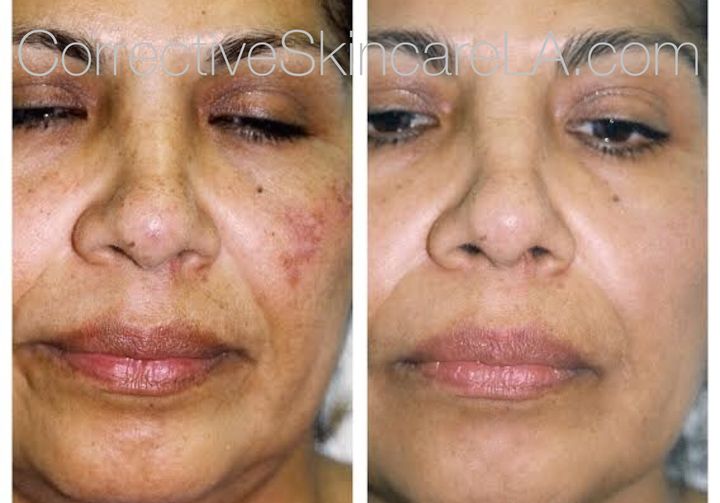
There has there been a lot of misinformation about Hydroquinone – the ingredient used to lighten dark patches of skin. Google the side effects and you'll find them. Google the benefits and you'll find those, too.
It can be hard to know the truth, or even know the right questions to ask! So here are the real facts behind Hydroquinone.
Hydroquinone has been used for over 50 years and was, for a short time, banned by the FDA. The ingredient works by decreasing the formation of melanin in the skin. Melanin is the pigment in skin that gives it a brown color. Hydroquinone-based products were banned temporarily when, in South Africa, high concentrations of those products (in upwards of 20 percent!) created a skin disorder called Ochronosis. It turned the skin an bluish shade. Not cool. But if you research a little further, you will also find that there were high amounts of illegal contaminants – including mercury – in those Hydroquinone products. The ban was lifted when researchers discovered this. But now, years later, there is still a stigma associated with using Hydroquinone.
When made properly, Hydroquinone is not a harmful ingredient. So if you're thinking about whether or not to use it to fade discoloration, get as much information about the product as you can. It is also important to learn about the causes of your discoloration, how to treat it and also how to prevent future discoloration of your skin. Here. Let me make this even more simple – I'll give you all of these answers below! Niiiice.
1. While the cause of discoloration is mainly genetic (the amount of melanin in your pigment is 100 percent determined by good ol' mom and pop) – hormones, sun exposure, heat, excessive and/or constant rubbing, injury, thyroid disease, and even stress can play a role in discoloration and melasma.
2. Melanin is produced naturally in the body so it's unrealistic to say we can 'cure' pigmentation. However, researchers have found that we can use products topically to 'inhibit' melanin production. Some of these topical products include: Hydroquinone, Kojic Acid, and licorice root.
3. Pair your topical lightening product with a chemical peel using a natural acid for home use or a deeper one at your favorite skin clinic or dermatology office (Glycol, Salicylic, Lactic, Vitamin A, etc. all work!) and you'll get your results so much faster! Why? The more detaching of superficial dead skin you can achieve, the less skin the lightener has to penetrate. This creates a much more efficient (and effective!) result.
4. Make sure the products you choose are as pure as possible; this means the less dyes, fragrances, and preservatives, the better. My products at Corrective Skincare are made by a in-house chemist. We added Kojic Acid to our Hydroquinone as a preservative so this means it must be refrigerated. Kojic acid is derived from fungi and fermented rice, so it's a completely natural compound. Products containing Kojic generally have a much longer shelf life because it resists oxidation and spoilage.
5. Speak to the person selling the product you are interested in. Do you trust him or her? Common sense generally rules in my book. If someone claims something is 'all organic' but has a shelf life of a year, or doesn't need refrigeration – I would be suspicious. Imagine a banana sitting out for a year and not spoiling. It's just not possible. I tell my clients that anything medicated lasts about four months before it starts to lose its potency. The more additives and preservatives these products have, the longer the shelf life – but this will also render the product less effective. I would rather use a product that is stronger and more pure but has a shorter shelf life. Gather as many facts as you can and then make your own judgement call.
6. Products and chemical peels don't guarantee that discoloration and melasma won't come back. Let's face it – for those of us who live in sunny climates, or love to be outside, it's difficult to get away from the sun. But prevention is key. Treatment of pigmentation requires the use of sunscreen. You must reapply SPF 30+ every two hours if in the sun. Wear protective hats, sunglasses, and lip balm. You didn't get melasma overnight and it won't go away that quickly, either. I am a firm believer that less product used more consistently over the long term will always be better than using products aggressively and/or intermittently. Doing the latter could burn you, potentially hyperpigmenting (darkening) you further.
There is a lot to know. But don't be afraid to ask the questions. Read the labels and familiarize yourself with your products. Don't have the time or energy? No problem! Ask a skin professional you trust.
Those of us who aren't using marketing tactics to make a quick dollar are never afraid to answer questions or give you insight from our personal experience to help you make your own informed decision. Because really, at the end of the day, that's all that matters.
